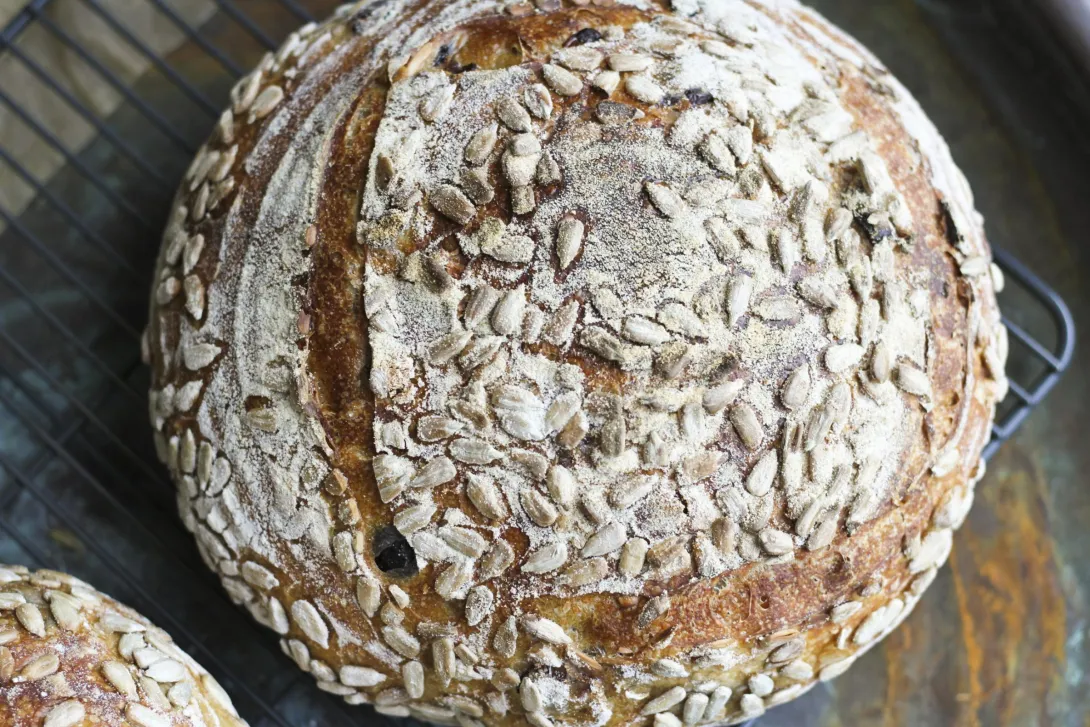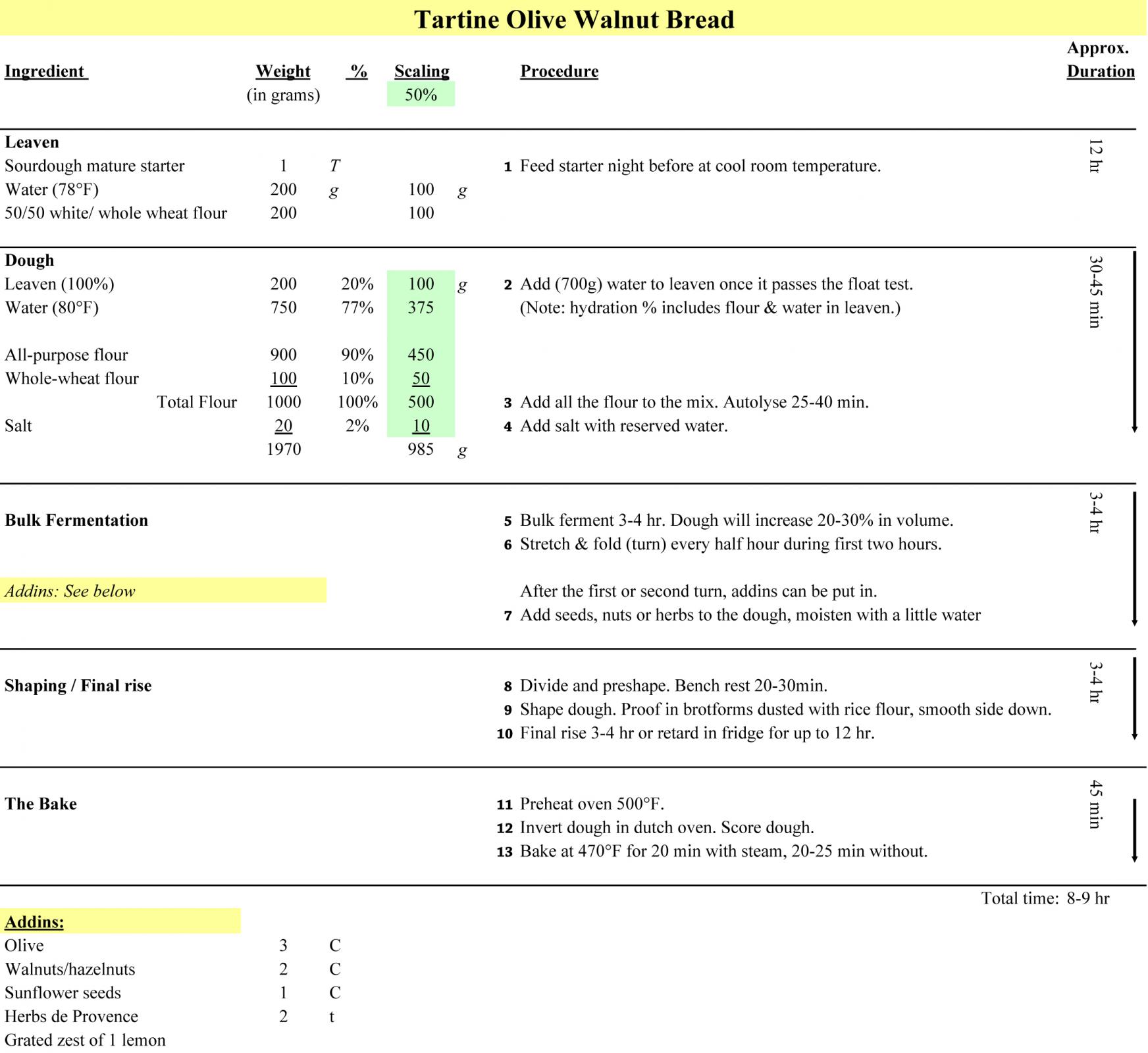
Breaking this bread is tantamount to opening a holiday present. At least, it feels that way when I cut the bread. The abundant good eats: olives, walnuts, sunflower seeds, herbs de Provence, lemon zest, filled the interior to the rim, are what make this bread sing.
This Tartine olive walnut bread uses a young leaven (20% of flour weight) and 10% whole wheat flour. Nothing out of the ordinary. However, the big winner is with all the add-ins, especially the olives. Since the dough is quite wet, series of stretch-and-fold help to strengthen it. I sprinkled more sunflower seeds around the proofing basket to prevent the dough from sticking. The dough was retarded in the fridge overnight. I made a full recipe (see the cheat sheet below for details) and baked two large loaves in Dutch ovens (one round, one oval) in a preheated 500°F oven. Lower the oven temperature to 475°F as the loaves are loaded. Finally, bake for 15 minutes with the cover on and 20-25 minutes uncovered.
All the olives, nuts, seeds and herbs make for quite a substantial bread. The bread stands on its own with its fairly loud flavors. Like all good breads, serve up with some fine cheese and wine, nothing can be better!

Adapted from Tartine Bread by Chad Robertson
- Flour.ish.en's Blog
- Log in or register to post comments
That is a beauty. Would you mind if I shared it on the homepage for a bit?
Absolutely. That'd be my pleasure to see the bread on the homepage.
Agree totally with Floyd, What a beautiful loaf inside and out!
Please say "yes"
Mini
Thank you for your kind words.
What a good idea to add sunflower seeds to the outside! I may have to try this loaf!
Whatever leftover bran or seeds I have, I use them to coat the bottom and side of the basket. That works.
Will have to give that a try this weekend! Thanks for the post; looks fantastic!
Thanks! The better the olives, the better it'd taste. Chad Robertson recommends using green lucques olives, that's what I'd try next time.
A treat for the eyes, as well as for the palate. Nice job and thanks for sharing!
You've nailed it. I have forgotten about this bread until my husband requested it. I bet he remembers the bread by its taste. It's strong and bold.
and I add Mediterranean herbs but have never paired that with walnuts and seeds. I have to try this combination. This bread looks so tempting from outside and inside.
Happy baking!
Joze
However, I used Forkish's Pain de Campagne recipe (only because I recently had some good success with it) :)
http://www.thefreshloaf.com/node/52476/pain-de-campagne-flour-water-salt-yeast-forkish
This time I scaled down the amount of levain made to reduce Forkish's "spent fuel" :) Didn't have any walnuts, so I used some chopped, toasted pecans which (with a pre-bake taste test) seemed to go well with the Kalamata olives (drained, rinsed and dried). For herbs, I used a little (~1/2 tsp) of an Italian blend (Marjoram, thyme, rosemary, savory, sage, oregano). I cut the salt in half because of the brine in the olives (just a guess). I'll put the full amount in next time.
Your hydration is about the same as Forkish's (78% vs 77%). All went well with the levain (I used my 100% hydration rye / whole wheat starter just for the heck of it). Dough: Autolyse 30 minutes; four S&F's at 20-minute intervals (ingredients added during the last S&F) and bulk fermented for about 6 hours.
Now here's my issue. While I have no problem forming a boule with this hydration, I found it impossible to get any kind of "structure" because of the ingredients. I don't see how you can form a tight boule when the ingredients are in the way...The boules were cold proofed overnight in rice flour dusted bannetons for 10 hours at which time they were almost doubled in size. Baked at 475F in dutch ovens; 30 minutes covered / 20 minutes uncovered.
My previous Pain de Campagne had very nice oven spring and a crumb of large, irregularly shaped holes. This bake didn't show much in the way of oven spring at all (over proofed?). BTW, how the heck do you know when a dough is proofed properly after it's been refrigerated? Refrigerated dough is so stiff... While it wasn't a totally dense crumb, it just wasn't as open as I thought it would be.
Don't get me wrong. The crumb is pretty darn pleasant, the chewy crust has a nice delicate crunch to it (even 3 hours later) and the flavor is outstanding (with just a bit of Irish butter on it). It's just that I didn't get the height I expected (which I attribute to how badly I formed the boules). Any ideas?
Great attempt. I guess, we tend to be our toughest critic. The crumb shot is what I'd expect from this bread with the amount of add-ins, which is quite a lot. The oven spring of the basic Tartine dough (without anything added) is certainly more exuberant than that of the olive walnut bread. Clearly, all the add-ins cut into the gluten development. I see several potential issues based on what you wrote.
Tartine starter is 50/50 whole wheat and all-purpose flour. More active than the Forkish's starter made up of a 20/80 composition. Hence the difference in the fermentation schedule. Shorter bulk fermentation is required for the Tartine dough, all else being equal.
Another issue is when the olives and walnuts are added. That should occur early on during the first or second series of stretch and fold which takes place in the first hour into the bulk fermentation. That explains the difficulty you encountered in incorporating all the add-ins in the dough.
Lastly, I prefer underproofing rather than overproofing to achieve the desirable oven spring. I judge its readiness by the degree the dough has risen before and after the cold retard. The dimple test has not always worked for me. Furthermore, I bake the dough directly from the fridge into the red hot Dutch oven. I generally preheat the oven with the Dutch ovens in it at 500°F for an hour. I also score the dough. You can tell as you are slashing the crust as to how vigorous the dough is. The size of the Dutch oven should be as close to the size of the dough as possible, which allows the dough to rise upward and not to spread sideway.
I have written about comparison between the Tartine and the Forkish methodology. Here is the link: http://www.thefreshloaf.com/blog/flourishen?page=1
Finally, in the interest of full disclosure, I have made the olive bread successfully many times with the Tartine method, but I haven't made the olive bread with the Forkish method. Therefore, my observations and comments are purely anecdotal. Hope this helps!
Regarding the timing of incorporating the add-ins, I thought I'd be able to get more development by doing all the folds first and then gently adding / folding in the ingredients.
I too bake directly from the refrigerator to the hot DO's. I turn the boules onto parchment paper (these boules flattened out a bit), score, and then load them into the preheated DO's (using the two ends of the parchment paper as "handles"). With a little bit of wiggling, I'm able to fit the boules in (they don't spread out). Next time, I'm going to trim around the boules and just leave two small strips on either side. This way, the boule will still be supported, but the paper won't crinkle up in the DO and "deform" the bottom of the loaf as it bakes.
I have the Tartine book, I'll have to give it a try. Thanks for the link to your comparison sheet; very informative. I'm relatively new to SD breads. Much to learn.
Once you get the add-ins incorporated, the dough is quite manageable. If you look for the ultimate oven spring, I've found the liquid levain (125%) using bread flour tops the list. Most of the Vermont's sourdough breads use a very wet liquid levain and it's very forgiving. You might want to give it a try.
Made this one this morning. It is delicious and very soft and light.
This is an amazing-looking bread. And I know for a fact that the taste is equally memorable. It's a crowd pleaser. Well done!
I love making this bread and adore eating it; it's a wonderful combination of flavours. Just wondering though, with so much already happening flavour and texture-wise, whether you think the addition of the seeds on the crust a bonus, or just a bit too much? Looks great though.
If you like seeded bread such as this one: http://www.thefreshloaf.com/node/50387/nordicstyle-sprouted-buckwheatspelt-loaf, a dense bread filled with seeds and nutrients, you'd probably like the idea of adding plenty of seeds. It is a meal in itself, almost. Or pack it for a long hike. Honestly, I like the crunch on the olive walnut loaf. I pick on the seeds on the crust. I can eat a handful of them.
Other times I bake a simple bread to make crostini. Or just eat it plain with just a smear of butter or jam. So it all depends — what you eat with the bread. I love making different kinds of bread for different occasions, seasons and venues. It's all fun.
Does this recipe call for 1 gram, or 1 Tablespoon of seed culture for the levain?
After re-reading it must be 1 Tablespoon.
What a great looking loaf.
Chad Robertson promotes using "young" levain with very little acidity. It smells sweet and yeastier as compared to other sourdough. To make it, only a small amount of starter is used. Yes, it takes only one tablespoon to build.
Looks like you nailed the Tartine method. Congrats! I love this bread. The method is impeccable and you can do literally anything with it.
I use the Tartine method as a base for many breads. After a while, it becomes second nature. I like the idea that there is the master formula that you can build on. You've got the essence of it.
What a beauty....stunning! Kat